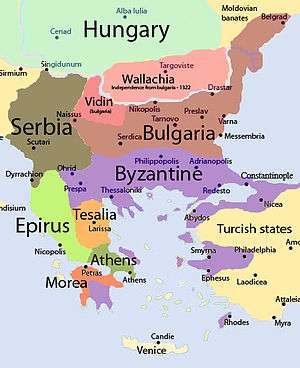Byzantine civil war of 1321–28
| Byzantine civil war of 1321–1328 | |||||||
|---|---|---|---|---|---|---|---|
| Part of the Byzantine Civil Wars | |||||||
 Byzantine Empire and surrounding territory in 1307, shortly before the First Palaiologan Civil War. | |||||||
| |||||||
| Belligerents | |||||||
|
|
| ||||||
| Commanders and leaders | |||||||
|
Andronikos II Syrgiannes Palaiologos[lower-alpha 1] |
Andronikos III John Kantakouzenos, Theodore Synadenos, Syrgiannes Palaiologos[lower-alpha 1] | ||||||
| Strength | |||||||
|
Unknown - Numerous Bulgarian, Serbian, and Tartar mercenaries, - Smaller number of supporters. - Population of Constantinople. |
Unknown, - Numerous mercenaries - Younger nobility - Included more supporters, including non-combatants, - Population of Thrace and Macedonia. | ||||||
| Casualties and losses | |||||||
| Unknown, but also possibly comparatively light | ||||||
The Byzantine civil war of 1321–1328 was a series of conflicts fought in the 1320s between the Byzantine emperor Andronikos II Palaiologos and his grandson Andronikos III Palaiologos over control of the Byzantine Empire.
Prelude to the civil war
Following the accidental murder of his brother Manuel over a love affair, the emperor Andronikos II excluded Andronikos III from the succession, while Michael IX, the son of Andronikos II and next in line for succession, died from shock over his son's death.[1]
1321: First conflict
Andronikos III had many supporters, chief among them John Kantakouzenos and Syrgiannes Palaiologos, who bought themselves governorships in Thrace, where discontent with the old emperor was high. On Easter 1321, Andronikos III fled the capital to Adrianople, where he set up his court and initiated an uprising against his grandfather. Syrgiannes Palaiologos led a large army towards the capital, forcing the old emperor to negotiate.[2][3][4] On 6 June 1321 a peace agreement was concluded, whereby Andronikos III was recognized as co-emperor and assigned Thrace and districts in Macedonia, while the rest, including Constantinople, remained under Andronikos II, who, as senior emperor, would also direct the empire's foreign policy.[5]
1322: Second conflict
The peace agreement of 1321 did not last long, as both Andronikoi pursued virtually independent foreign policies. Within the faction of Andronikos III a rift arose between the Syrgiannes and megas domestikos John Kantakouzenos. Syrgiannes felt that he had not been sufficiently rewarded for his support, and he also resented the greater favour shown by Andronikos II to Kantakouzenos. Furthermore, there is also a story that Andronikos III attempted to seduce Syrgiannes' wife.[2][6] As a result, in December 1321 Syrgiannes switched support to the old emperor, fleeing to Constantinople. Rewarded with the title of megas doux, he then convinced Andronikos II to resume the war.[3][7][8] After several cities in the area of Constantinople went over to the younger Andronikos, another agreement in July 1322 restored the previous status quo. This agreement between grandfather and grandson left Syrgiannes in an awkward position. Having failed in his endeavours, he began plotting to assassinate Andronikos II and seize the throne for himself. The plot was foiled however, and Syrgiannes was sentenced to life imprisonment.[7][9][10]
On 2 February 1325, Andronikos III was formally crowned as co-emperor by his grandfather. Although there was little fighting during this conflict, the effects had a major impact on the empire: constant troop movements from levied peasants reduced agricultural production and trade was severely interrupted.[11]
1327–28: Third conflict
In February 1327 a new conflict occurred between Andronikos III Palaiologos and his grandfather Andronikos II Palaiologos, but this time the Balkan countries were involved in war. On Andronikos II Palaiologos' side stood the Serbian king Stefan Decanski and on the other's Bulgarian emperor Michael Shishman, as agreed by the Treaty of Chernomen. Battles were fought for the Macedonian territories and after this victories these territories along with the city of Salonika went into hands of Andronikos III Palaiologos. In January 1328 Andronikos III Palaiologos and his commander John Kantakouzenos entered Salonika. After these victories in Macedonia, Andronikos III decided to capture Constantinopole and in May 1328 he entered into city and forced his grandfather to abdicate and took power in charge. Two years later the old emperor was taken to a monastery where he died on February 13, 1332
With Andronikos III Palaiologos (1328–1341) came a new generation with John Kantakouzenos as leader, who was in charge of politics while Andronikos III was in charge of army. The civil war exhausted the empire, the value of money dropped, but the new government took care of law and courts.
See also
Notes
Sources
- Bartusis, Mark C. (1997), The Late Byzantine Army: Arms and Society 1204–1453, University of Pennsylvania Press, ISBN 0-8122-1620-2
- Bosch, Ursula Victoria (1965), Kaiser Andronikos III. Palaiologos. Versuch einer Darstellung der byzantinischen Geschichte in den Jahren 1321–1341 (in German), Adolf M. Hakkert
- Fine, John Van Antwerp (1994), The Late Medieval Balkans: A Critical Survey from the Late Twelfth Century to the Ottoman Conquest, University of Michigan Press, ISBN 978-0-472-08260-5
- Kazhdan, Alexander, ed. (1991), Oxford Dictionary of Byzantium, Oxford University Press, ISBN 978-0-19-504652-6
- Jeffreys, Elizabeth; Haldon, John; Cormack, Robin, eds. (2009), The Oxford Handbook of Byzantine Studies, Oxford University Press, ISBN 978-0-19-925246-6
- Nicol, Donald MacGillivray (1993), The Last Centuries of Byzantium, 1261–1453, Cambridge University Press, ISBN 978-0-521-43991-6
- Nicol, Donald MacGillivray (1996), The Reluctant Emperor: A Biography of John Cantacuzene, Byzantine Emperor and Monk, C. 1295–1383, Cambridge University Press, ISBN 978-0-521-52201-4
- Treadgold, Warren T. (1997), A History of the Byzantine State and Society, Stanford University Press, ISBN 0-8047-2630-2
- Ostrogorsky, George (1969), History of the Byzantine State, Rutgers University Press, ISBN 0-8135-0599-2